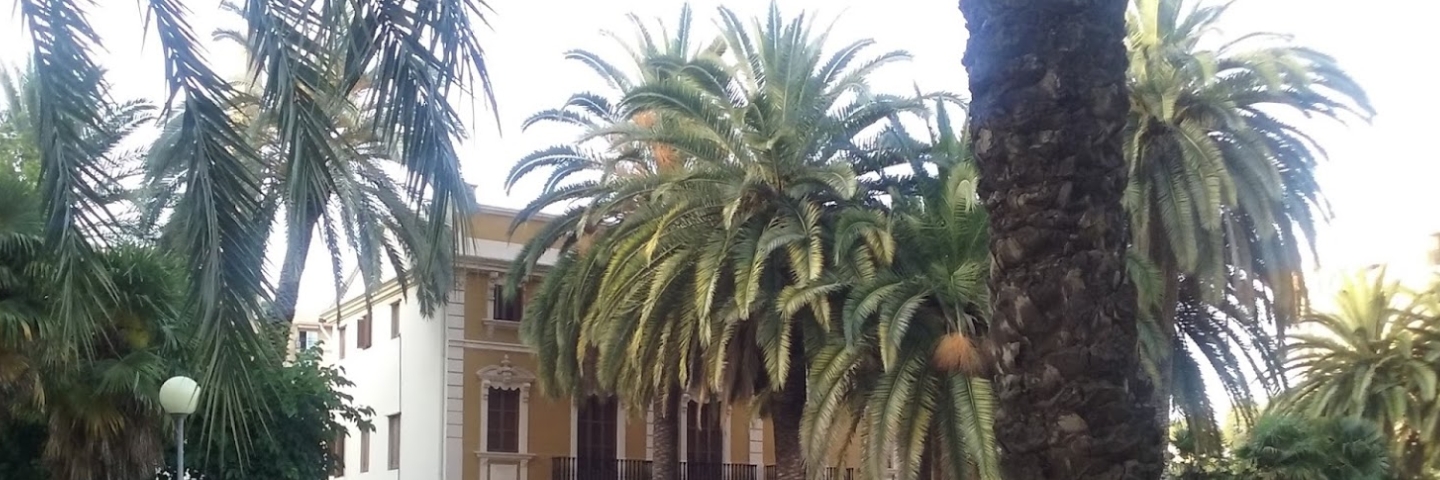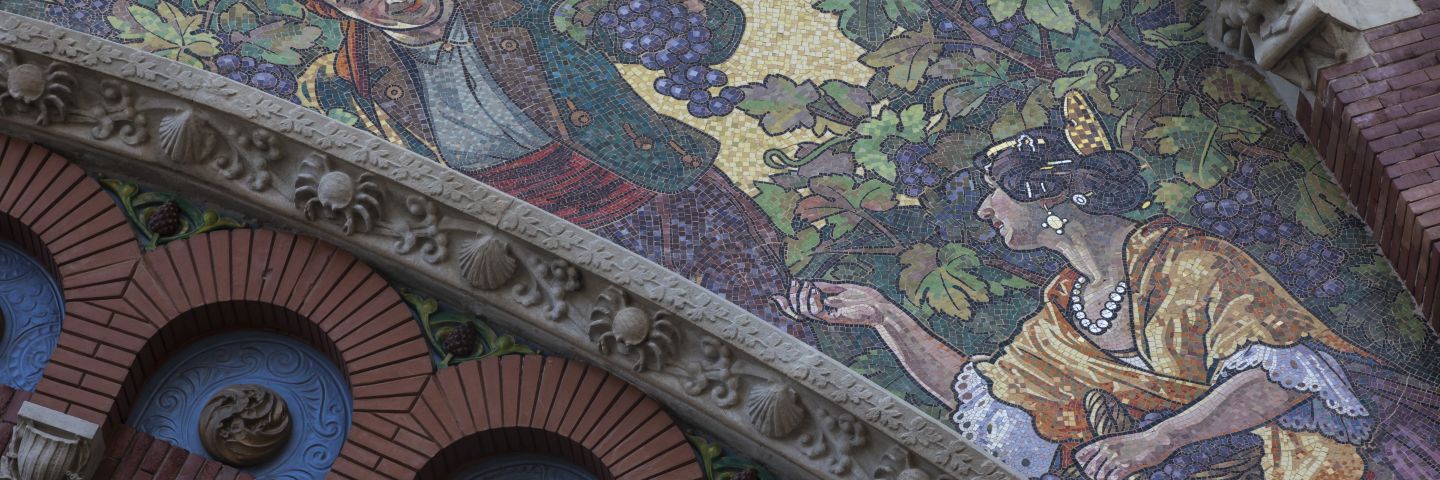The original station of the Northern Railway Company was located at the confluence of Carrer de Ribera and Plaça de l’Ajuntament, but the transformation that took place in this area in the early twentieth century and the need to facilitate traffic through the ring road, advised its move away from the center.
Archives: Monumentos
Palace of Exarchs
The palaces must have been the residence of the Exarch, a noble family from the world of commerce, as evidenced by the reference, in royal documents, to the recommendation of King Alfonso the Magnanimous towards members of this family for trade between the kingdoms of Valencia and Granada (silk and other Granada textiles).
The origin of the construction is uncertain, the presence of the Exarch family in Valencia dates back to the s. XLLL. The first constructions, or adaptations of the buildings as palaces, could date from the s. XLV probably a single manor house in origin, linked to the Exarch family and later divided into different houses. Ignatius of Loyola probably settled in these houses on his visit to Valencia in 1535 and this is the reason why the chapel built in the seventeenth century is dedicated to this saint.
The complex consisted of five palaces with similar characteristics, originally apparently forming a single block, but this situation must have been modified over time, leaving numbers 9 and 11 independent. Later number 11 was demolished and currently the space it occupied is built leaving only the large entrance portal as the only memory of the old palace and number 9 is a convent of the Capuchin Trinitarians, remodeled in 1978.
Numbers 3, 5 and 7 that are currently in disuse form a unitary construction. On the outside it is difficult to perceive unity, since the three buildings are clearly delimited, on the other hand, inside the distribution is that of a large house.
Exhibition Centre
The Palace was conceived as ephemeral architecture in the early twentieth century on the occasion of the 1909 Regional Exposition, held in Valencia. According to Francisco de Mora, the building is inspired by the monuments that Valencia possesses of its period of greatest splendor, models of ogival art that the Valencian citizens will admit as their own.
Original configuration
The Palace is a unique building with five facades, and two floors organized around a courtyard. It is located on the corner of the block shared with another building built for the Exhibition, the Old Lactation Asylum.
The building is developed in two sectors, the main wing, which occupies the entire front of the Plaza de Galicia, and the other area that occupies the rest of the plot and is organized around a large courtyard. Both parts are topped at the extreme corners by a square tower and are articulated in the chamfer by the octagonal tower.
The noble area consists of a semi-basement and two high-rise floors with terrace, together with the finish of the towers above the roof. A wide staircase occupying three of the five arches of the main façade leads only to the upper floor. It is illuminated by a skylight of feathered colored glass and adorned with a canvas of the time, the work of José el Genovés. On the main floor is the reception hall, with stained glass windows overlooking the Plaza de Galicia, plaster coffered ceilings, nolla mosaic floor and tile plinths. It had lamps and even its own furniture, designed for the occasion in the medieval style of the Palace.
Villa Vista Alegre
Located on Guardia Civil street, this house dates from the early twentieth century being the residential country house of the Martí family, a bourgeois family, who used this villa as a summer house.
During the civil war, the house was used for evacuees from the war. There were as many as 60 people protected there. It had a large shelter that was used without thinking whenever bombs were heard.
Next to the house, a factory was built that was also owned by the Martís and of which today remains the unique testimony of the chimney that is a few meters from the house. It was a vegetable canning factory, especially tomato, in which there were many workers. It operated until 1956. The house was used until 1980.
This villa is today a building for public use, known as Chalet Martí, by the surname of its last owners. There is the Municipal Exhibition Board, where various administrative procedures are carried out corresponding to the 6th, 14th and 15th districts of Valencia.
Sánchez de León Building
At the confluence of the San Vicente Street and of the Plaza de Santa Catalina, with a magnificent view from the Plaza de la Reina, is a unique residential building, the Sánchez de León House (once warehouses of the same name), which was built by the master builder Lucas García Cardona in 1896, at the request of the merchant Pedro Sánchez de León, bearing his name long years the warehouses that were installed there.
The building, of eclectic style, corresponds to the type of multi-family residential buildings, produced in the late nineteenth or early twentieth century (1875-1917) associated with areas of urban reform that allow the increase in the generalized size of all variables: height, size, division and number of dwellings per building.
Balmes Palace
During the Middle Ages, wood artisans were very important social agents for the use of this raw material for the construction of houses, boats, tools and the vast majority of containers and objects of daily use.
In Valencia, the River Turia represented a direct route of arrival of wood from the mountainous regions of Cuenca, Teruel or Ademuz and, after the Christian conquest of the old Kingdom, one of the first guilds of carpenters was created. In fact, on January 17, 1.242, the Distribution Book already assigned to the master carpenter Guillem Francolí two workshops in front of the Church of San Martín in Valencia, a parish where workshops of other wood craftsmen were installed and it became a guild headquarters until 1,479, when the Valencian wood craftsmen themselves raised the Balmes Palace for the meetings of the “Confraria e ofici dels fusters”.
Columbus Market
Located in one of the largest blocks of the first Eixample, it is one of the most important pieces of modernism in Valencia. Its construction began in 1914.
Designed by Francisco Mora Berenguer It provides as a novelty in this type of markets its open character, which allows the view through it producing a pleasant feeling of diaphanousness and transparency, perceptible fundamentally in its largest sides, which undoubtedly constitutes an original and appreciable success. The metal structure on cast iron pillars is framed by two powerful brick ends, perforated by imposing arches, in which there is a brilliant ornamental use of various materials, mainly stone and mosaic, forming a unique composition.
Ruzafa Market
It was designed by Julio Bellot Senet, according to the agreement of the City Council of 1954 and began the works at the end of May 1957. It is located in the heart of the Ruzafa neighborhood, opposite the baroque church of San Valero, in an area that has undergone rapid modifications of the initial urban structures with the inclusion of residential buildings of much greater height.
Tossal Gallery
In this square is the Tossal Gallery where you can see the musealized remains of a tower and canvas of the Islamic wall of the twelfth century.
Central Market
Since the Middle Ages, Plaça del Mercat has had a strong commercial vocation. Here the market was held, first in open-air stalls – the popular “stalls” with their white awnings and colorful merchandise displayed to the public – which from 1839 were completed with a building built for this purpose. With the turn of the century, however, the need for a larger capacity facility became evident.
Mossén Sorell Market
In this place there was already in the eighteenth century a small square, which was widened and regularized at the end of the following century, after the voracious fire that completely destroyed the Gothic palace of Mossén Sorell. The space defined by this new square has occupied since the late 1920s a small public market, designed by the municipal architect Àngel Romaní.
With an almost square floor plan, its stalls are located next to two interior streets that intersect in a slender central roundabout. Built with modern materials, concrete and iron, its roof plan has five octagonal prisms, one central and large on the roundabout and four small at the corners. Rehabilitated in 1987, replacing materials and trellising its outer perimeter, it continues to function as a vital infrastructure of the neighborhood.
Bullring
The bullfighting festivals have always enjoyed a great reception among the Valencians, both the horseback spears and the -more recent- bullfighting on foot. Until the eighteenth century the shows took place in the market square, although later some races were held in the Plaza de Santo Domingo.











